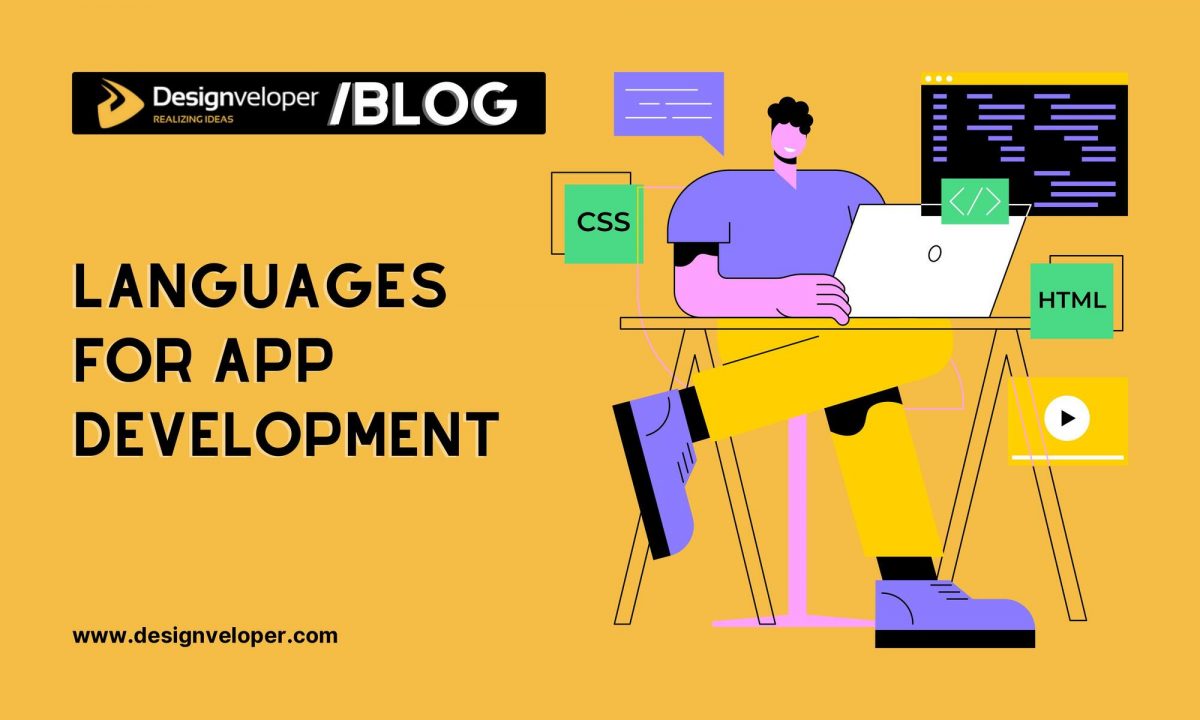Have you pondered how to make a unique digital footprint? An engaging app, tailored to address your audience’s challenges, is the key. If you’re a beginner in app development and eager to navigate the digital landscape, this guide is your compass.
Reading this article, you’ll discover the key factors to consider before app development and a comprehensive guide on how to create an app effectively. These secrets help you craft an app that not only resonates with your audience but propels your business into the digital spotlight in 2024.
So, are you ready to transform your app idea into reality? Stay tuned!
5 Things You Need to Know Before You Create an App
Before you dive into the exhilarating world of coding and unleash your app masterpiece on the world, hold up! Building an app without proper preparation is like jumping headfirst into a coding canyon – exciting, sure, but potentially disastrous.
So in this section, you’ll be equipped with the essential groundwork, from choosing the right platform to understanding your audience’s desires, to ensure your journey of how to create an app goes smoothly, without any accidents.
Identify Your Platforms (or Operating Systems)
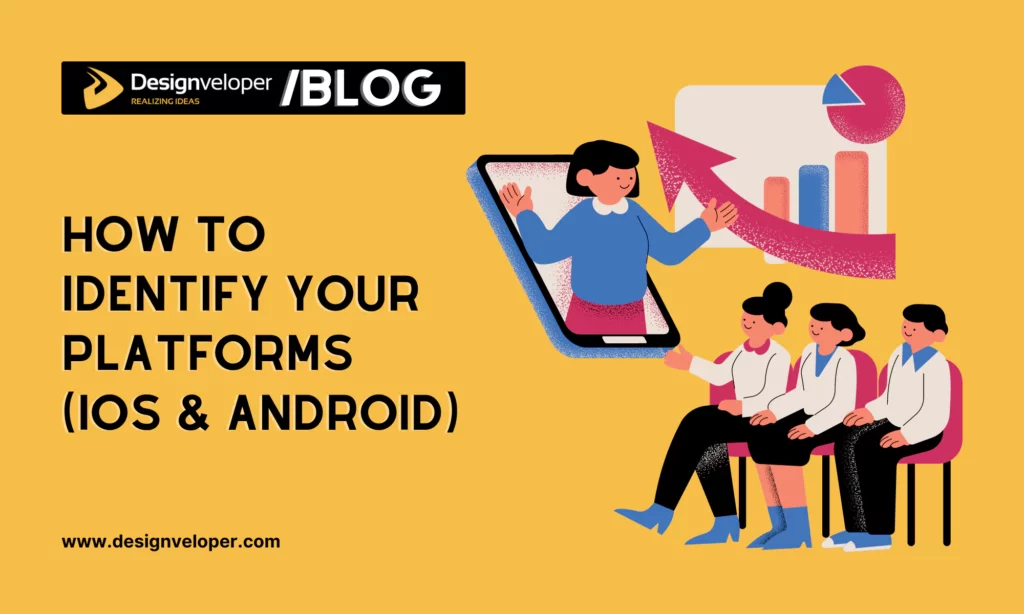
Today, Android and iOS are two titans dominating the app landscape. If you wish to craft a native app (that is tailored for a specific operating system), then which platform should you choose? The answer lies in the following factors:
- App development goals: For global reach and maximum customization, choose Android. Meanwhile, iOS is perfect if you prioritize security, a streamlined experience, and a faster development cycle.
- Software compatibility: Decisions on software compatibility – think plugins, APIs, and specific features – are heavily influenced by your platform choice. For example, an augmented reality app might thrive on iOS’s LiDAR technology, while a social media app may benefit from Android’s deeper hardware integration.
If you want something to work well on both iOS and Android, consider cross-platform development. This can be a cost-effective and time-saving solution, especially if you’re targeting a broad audience. Using tools like React Native or Flutter can help you build one codebase that runs seamlessly across platforms.
At Designveloper (DSV), we offer flexible strategies for your cross-platform needs, considering budget and time constraints:
- Web and Mobile App Separation: For optimal development and budget flexibility, we build separate web and mobile apps, ensuring a seamless user experience across platforms.
- Responsive Web with Webview Integration: For tighter timelines and budgets, we leverage a responsive web app embedded within a mobile app. This approach allows for faster development while still providing a mobile app experience.
Understand Your Potential Users
Before app development, it’s essential to identify who will use your app and what problems it will solve for them.
Start by asking questions like: What age group does your audience belong to? What are their interests? What challenges do they face that your app can solve?
Once you’ve gathered this information, you can create a user persona. A user persona is a detailed profile of your ideal customer, capturing their demographics, goals, needs, and pain points. It’s like a mini-biography that helps you understand who you’re building your app for, hence guiding your design decisions.
For example, if you’re creating a fitness app, your user persona might be “Fitness Fiona,” a 30-year-old office worker who wants to stay healthy but struggles to find time for the gym. Your app could offer quick, effective workouts that Fiona can do anytime, anywhere.
Remember, understanding your potential users is not a one-time task. It’s an ongoing process that continues as long as your app is in use. As you receive feedback and learn more about your users, you can refine your persona and make your app even better.
Validate Your App Idea
Before diving into how to create an app, it’s crucial to validate your app idea. The goal of validation is not just about confirming your app idea but also about refining it. To prove whether your idea is a possible solution to existing problems, conduct market research.
This helps you assess the demand for your app and understand the competition in the market. Start by identifying your target audience and understanding their needs. Use online surveys, social media polls, and direct interviews to gather data about potential users’ preferences and behaviors.
Then, analyze your competitors. Look at the top apps in your category on app stores. Understand their features, user reviews, and pricing strategies. This will give you insights into what works and what doesn’t in the current market. Accordingly, it helps you discover whether there’s a need or a problem that your app idea can address.
Decide Your Development Partner
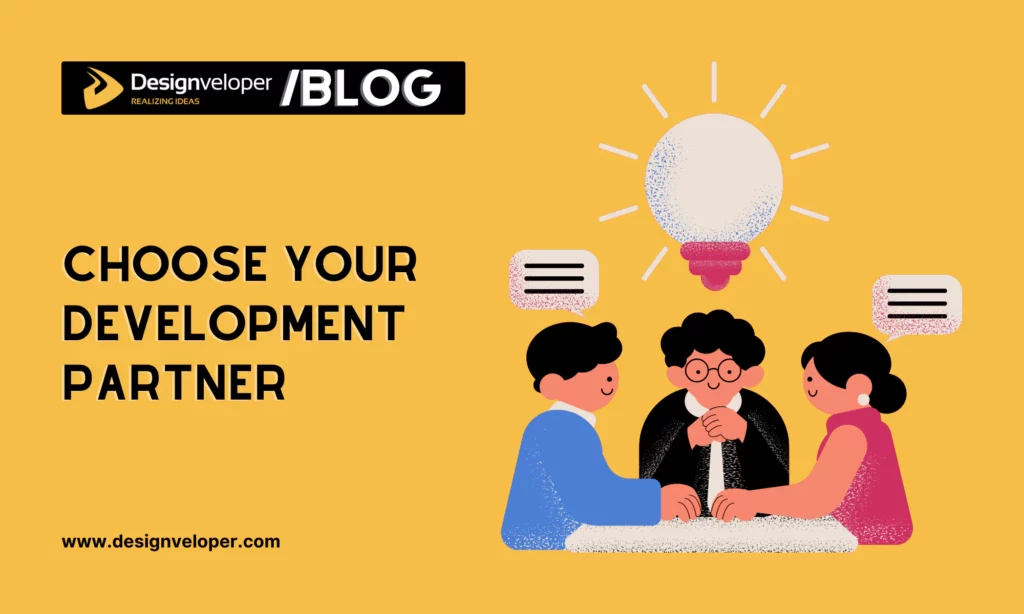
When you’re figuring out how to create an app, choosing the right development partner is a critical decision. This choice should be based on your budget, skillset, and the complexity of your project. You have three main options: use internal developers, hire a freelancer, or outsource your app to an app development agency.
Use In-House Developers
If you have the resources, hiring internal developers can be a good option. This approach allows you to have a dedicated team working on your app, providing you with more control over the development process. However, this requires a significant investment and the ability to manage a technical team.
Hire a Freelancer
Freelance developers can be a good option if you need specialized skills or if your project is relatively small. However, managing a freelance developer requires a certain level of technical knowledge and project management skills. Besides, cultural fits might be a big concern to many employers.
Outsourcing Your App
Outsourcing your app development to a company can be a great option, especially for complex projects or if you lack the necessary technical skills. An outsourcing company like Designveloper (DSV) can provide a comprehensive service, from estimation to tech stack recommendation and expertise. This approach allows you to use essential resources, considering budget and time to market, and avoid unnecessary features during app development.
So how can a company like DSV help you tackle such issues? It’s by following a structured process when approaching a client’s idea or request:
1. First Meeting: The initial meeting involves a discussion between both parties to understand your needs. This includes discussing project requirements, a list of desired features, and any enhancements or additions needed for existing apps or websites.
2. Rough Estimation (RE): DSV’s sales team, in collaboration with experienced business analysts, developers, designers, and quality control specialists, gathers project information and creates a list of essential features. We then provide a rough estimation that covers cost, timeframes, and expected resources.
3. Detailed Estimation (DE): After you review the rough estimation and agree on the proposed budget, timeline, and selected features, we establish a dedicated project team. This team provides a detailed estimation (DE) that includes specific features, costs, detailed work breakdown, and a specific development schedule for each project phase.
We also recommend the following tech stack to cater to your unique needs. For example, DSV utilizes Amazon Web Services (AWS) for managing the project’s infrastructure, ensuring scalability and reliability. Meanwhile, for database solutions, we suggest either MongoDB or PostgreSQL. The choice depends on the specific project requirements and data handling needs.
By following this structured approach and recommending these preferred tech stacks, DSV ensures that clients receive tailored and efficient solutions that meet their project goals and deliver exceptional results.
Plan UX/UI Design and Security
When planning how to create an app, two crucial aspects to consider are the User Experience (UX) and User Interface (UI) design, and the security of your app.
An intuitive and engaging design can enhance the user experience, leading to higher user retention and satisfaction. On the other hand, data privacy and security are of utmost importance in today’s digital age. As an app developer, you must prioritize implementing security best practices to protect your users’ data.
So, how can your app design smoothly lead potential users to your offerings or messages? Or how can you protect sensitive information from cybercrime or malware? Detailing the answers for these questions help you devise the best plan for your app’s UX/UI design and security. Accordingly, create a well-designed app that not only looks good and functions smoothly but also respects user privacy and keeps data secure.
A 7-Step Guide on How to Create an App in 2024
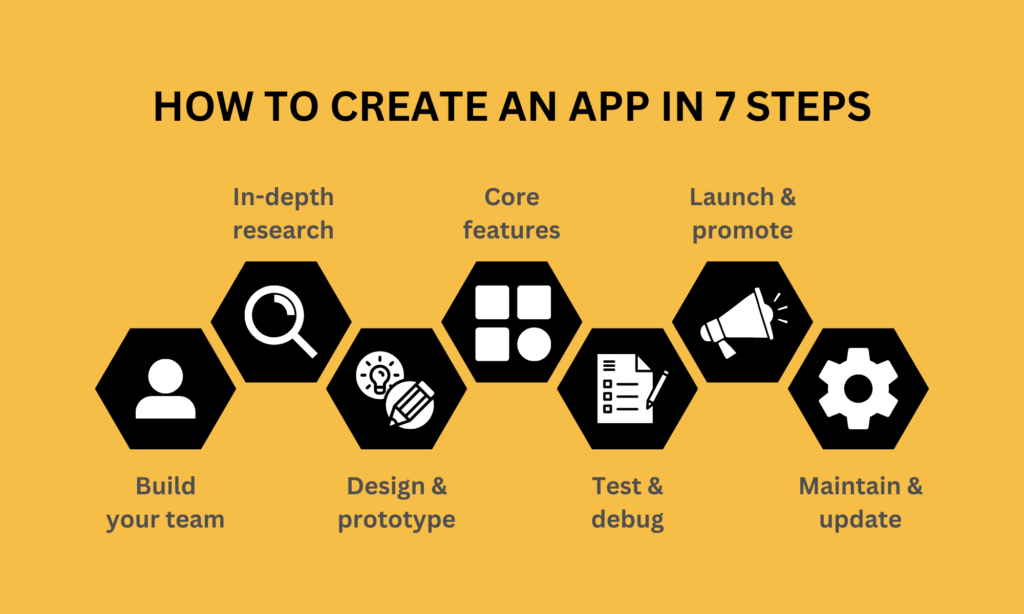
Creating an app can be a rewarding experience, but it can also be quite challenging, especially if you’re new to the world of app development. So after considering the key factors above, here are the next steps on how to create an app effectively. Keep reading to discover how to bring your app idea to life in 2024.
Step 1: Build a Development Team
Building a successful app development team is a crucial first step in any project. The team should ideally be composed of individuals with diverse skills and expertise. Here are some key roles that you should include in your team:
Project Manager: This individual oversees the entire project, ensuring that all parts are moving together towards the same goal. They are responsible for setting timelines, managing resources, and coordinating team efforts.
Software Developers: These are the individuals who will be doing the actual coding for your app. They can be frontend wizards who craft the visual interface or backend sorcerers who conjure the logic and data magic. Choose programmers versed in the platforms and languages your app demands.
UI/UX Designers: These individuals are responsible for designing the user interface and the user experience of your app. They ensure that your app is not only visually appealing but also easy and intuitive to use.
Quality Assurance (QA) Testers: QA testers are crucial for identifying bugs and ensuring that the app functions as expected across different devices and operating systems.
Besides the core crew, your app development project can involve optional players. They can be data analysts who help you understand how people interact with your app and refine it for maximum impact, or marketing specialists helping to create a marketing strategy for your app.
Also, this step is when your team picks up the right tech stacks tailored for the app project. Besides technologies, it’s crucial to consider communication and project management tools (like Slack and Trello) to ensure all team members and stakeholders track the project’s progress effectively.
Step 2: Conduct In-Depth Competitor and Market Research
After assembling your development team, it’s crucial to delve into market and competitor research.
While initial research validates your app idea and identifies your target audience, in-depth research during the development phase is equally important. So on the journey of how to create an app effectively, don’t overlook this phase.
This stage involves a thorough analysis of competitors’ strategies, products, strengths, and weaknesses. Also, research helps you stay on the latest app development trends. This ensures your app remains competitive and relevant in the ever-evolving market.
Here’s how to conduct effective competitor and market research:
Identify Your Competitors: Start by identifying apps that are similar to the one you plan to develop. Look at both direct competitors (apps that do the same thing as yours) and indirect competitors (apps that could satisfy the same user need). Tools like App Annie and Sensor Tower can help you identify and track your competitors.
Analyze Their Strategies and Products: Look at your competitors’ app design, functionality, and UX/UI design. Check out their marketing strategies and customer reviews as well. Using tools like StoreMaven and AppFollow can help you analyze your competitors’ strategies and products.
Understand the Market Trends: Stay updated with the latest app development trends. This could be anything from design trends to preferred programming languages or popular app categories. Following blogs and forums like TechCrunch, Mashable, and Stack Overflow can help you stay updated with the latest trends.
Understand What Your Target Audience is Doing: Understand who your users are, what they need, and how your app can help them. Using tools like Google Analytics and Firebase, you can understand your target audience better and then design an app that meets their needs.
Step 3: Design and Prototype Your App
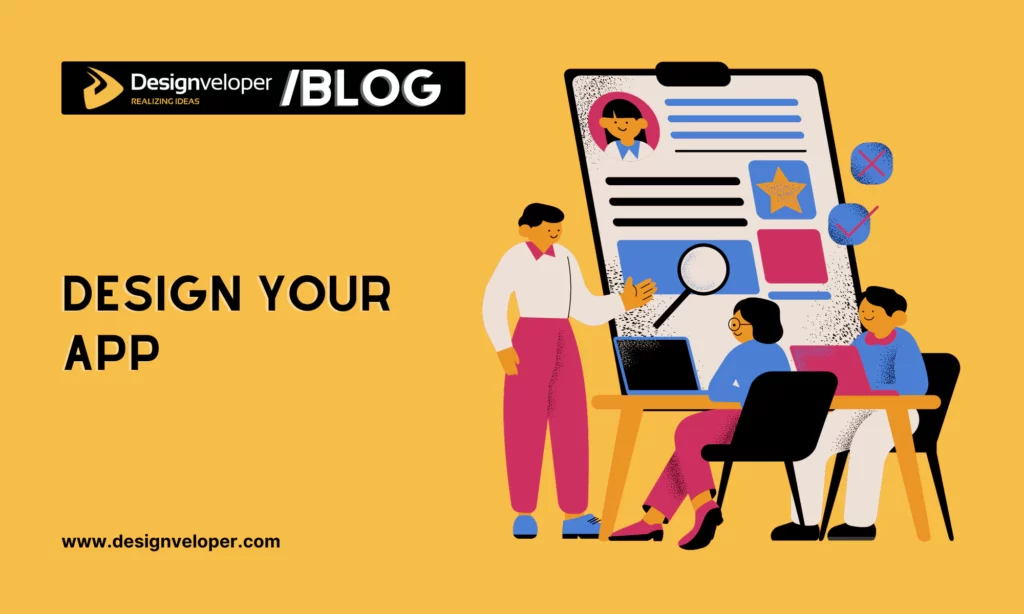
Moving to this step, you’ll bring your app idea to life through design and prototyping.
Start by creating a wireframe for your app. This is a basic sketch of your app’s layout and functionality. It helps you understand the flow and features of your app. Tools like Balsamiq and Sketch are great for wireframing. Once you have a wireframe, create a storyboard to visualize the user journey within your app. This helps you understand how users will navigate through the app.
After wireframing and storyboarding, develop mockups of your app. Mockups are detailed visual representations of your app’s design and user interface. They give you a clearer picture of what your app will look like. Tools like Adobe XD and Figma can help you create stunning mockups.
As mockups are typically static and do not include interactive elements, there’s a need to build interactive models, or prototypes, based on these mockups to test your design idea. Further, this also allows you to identify issues and refine your app before development begins. Prototyping tools like InVision and Marvel allow you to simulate your app’s functionality and make necessary adjustments.
Step 4: Build Your App’s Core Functionality
After successfully designing and prototyping your app, it’s time to shift gears and learn how to create an app’s core functionality.
In this stage, to make your app alive, you need to:
Focus on Essential Features: You should identify and build the core features that deliver value to your users. This is where you start crafting your Minimum Viable Product (MVP) – a version of your app with enough features to be usable by early customers who can provide feedback for future product development.
Integrate APIs and Services: Enhance your app’s capabilities by integrating APIs and services. This could be anything from payment gateways for in-app purchases, to social media APIs for sharing achievements. Use tools like Postman to test these APIs before integration.
Focus on Data Privacy and Security: Ensure you’re following best practices for data encryption, user authentication, and permissions on your app. Consider using services like Firebase Authentication for secure sign-in, and always stay updated with the latest security standards.
Step 5: Test and Debug Your App
Testing and debugging are critical steps in the process of how to create an app. To ensure a seamless user experience, adopt the following top tips for effective app testing:
Start Early: Don’t wait until launch to test! Integrate testing throughout your development cycle, catching bugs early and saving yourself (and your users) headaches. You can conduct either manual or automated testing to test how the elements of your app are functional, compatible, and accessed by all users, even the disabled.
Write clear test cases: Document your test cases with detailed steps so that they can be easily repeated and reused.
Focus on high-impact areas: Prioritize testing features crucial to your app’s success. Don’t let minor details overshadow core functionalities.
Use the right tools: There are many different testing tools available, so choose ones that are appropriate for your needs and skill level. Some widely used testing and QA tools like HP ALM, PractiTest, or Xray help identify and address technical issues easily, accordingly supporting you in modifying code to fix these problems easier.
Fix Bugs Quickly: Don’t let bugs linger, address them as soon as they are discovered. Besides, to save your time debugging, you can use issue tracker solutions to manage and maintain a list of issues or ‘bugs’ identified during the development process. This, accordingly, helps your team address problems on time. Today, the most preferred tool for issue tracking is Jira (68%), followed by GitHub (26%) and Trello (19%).
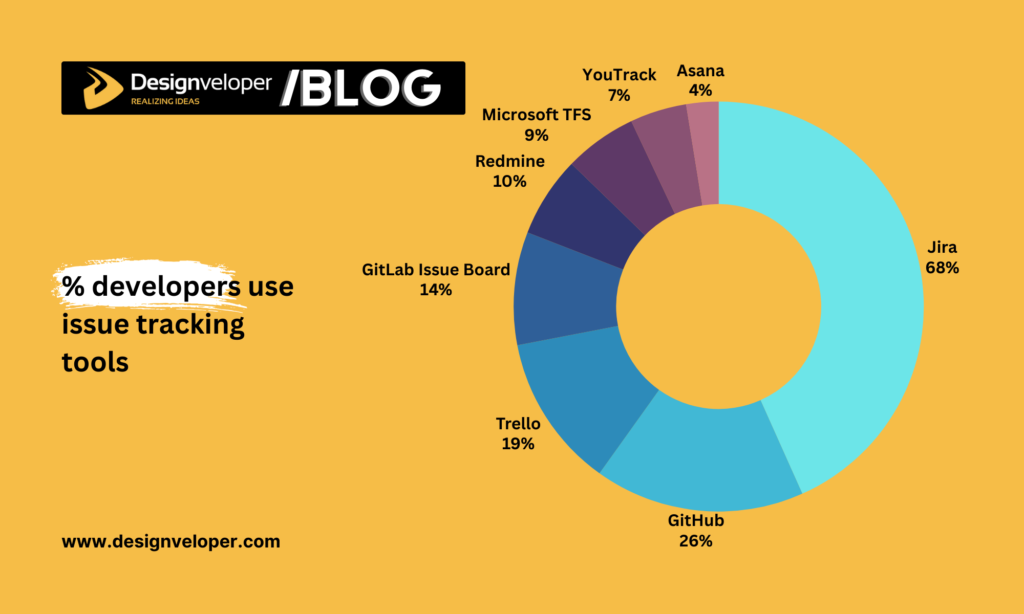
Hear the User Voice: User feedback is invaluable for identifying and fixing issues that may not be apparent during testing. To gather user responses, employ User-Based Testing. This testing method allows real users to test the app to ensure it can handle required tasks in real-world scenarios, according to specifications.
Step 6: Launch and Promote Your App
After the rigorous development and testing phases, it’s time to showcase your app to the world.
Begin by submitting your app to relevant app stores. Each app store has its own set of submission guidelines that you must adhere to. These guidelines often include specifications for app design, user privacy, content, and more. So, ensure your app abides by these guidelines to avoid the store’s rejection.
Once your app is available for download, utilize various marketing strategies to promote it. This could include social media marketing, content marketing, influencer marketing, or even paid ads. So, highlight the unique features of your app in your marketing campaigns to attract potential users.
Don’t forget App Store Optimization (ASO) unless you want to fade out in the app store. This is your secret weapon for climbing the app store charts. So, optimize your app title, description, and keywords to attract organic searches.
Step 7: Maintain and Update Your App
Even when your app is downloaded, it doesn’t mean the victory is entirely in your grasp. Only 4% of users remain active on an app after the first month since downloading. This highlights that not only attracting users to your app, but keeping them engaged is also equally important.
Besides, apps on the App Store and Google Play Store that haven’t been updated for a minimum of 2 years are also considered ‘abandoned’. And the number of abandoned apps on the stores increased another 6% last year.
Therefore, there’s a need for regular updates with bug fixes and new features to make your app ‘active’ and fulfill the ever-changing demands of your users. To do so, analyze user feedback and app usage data to understand what your users are expecting and improve your app accordingly.
Remember, app development is an ongoing process that requires continuous effort and improvement. The journey of app development is not just about how to create an app effectively, but also how to maintain and update it to continuously meet user expectations.
Final Words
In this guide on how to create an app, you’ve walked through key factors to consider before app development and the seven detailed steps to build an app. Remember, creating an app is not a one-time event, but a journey of continuous improvement. It’s about understanding your users, updating your app, and keeping it relevant. If you’re ready to start this journey, Designveloper is here to help. With our expertise, you can build an effective app that stands out in the crowded app market. So, why wait? Start your app development journey today!












